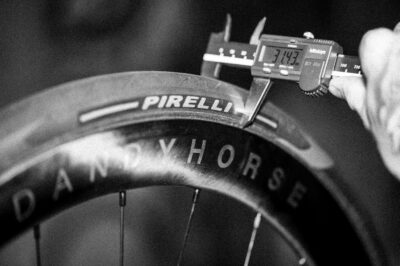
Usually, when a cyclist picks up a bicycle hub, he or she automatically turns the axle to check how well it spins (read: how much resistance the bearings offer). Cyclists like it when everything on their bikes runs smoothly, so any resistance is highly undesirable. To reduce drag to a minimum, so that all the generated power is converted into movement, a cyclist is even willing to sacrifice his family’s vacation budget to buy the best bearings for his bike. After watching a few suggestive videos showing wheels or cranks that, after replacing the bearings with ceramics, spin stubbornly for several minutes after a light push, the cyclist already knows that ceramics are the best choice. But will ceramic bearings really make you faster? Does how well the hubs spin in your hand have any bearing on your ride? The truth is, as usual, more trivial than marketing managers of companies selling expensive ceramic bearings would like.

To understand the issues related to the bearings used in hubs, it is necessary to have a general understanding of their construction. The bearings used in bicycles are most often ball bearings with double rubber seals. They are made of two steel rings – inner and outer, equipped with smooth raceways on which the balls roll. Steel or ceramic balls are enclosed in a basket made of steel or plastic. The basket is responsible for keeping the balls at a constant distance, and the rubber seals that protect the bearings from water and dirt from the outside. Seals are divided into two types: contact seals, which tightly adhere to the rings, thus better protecting the interior of the bearing at the cost of greater resistance, and non-contact seals, which offer much less resistance, but at the same time perform the protective function worse. In turn, whether the bearing is well sealed has a direct impact on its durability.
There are five main forces that slow down a cyclist during riding. Here they are, in order of importance, from the most annoying to the least significant:
During riding on flat terrain at a speed of 40 km/h, aerodynamic resistance accounts for about 90% of all resistances that the athlete faces. On the other hand, tire rolling resistance is about 95% higher than bearing resistance in hubs and bottom brackets. You don’t have to be Euclid to estimate that bearing resistance is of little importance to the said athlete. Let’s now consider which element of the bearings causes the greatest energy losses. The answer is in the graph below, provided to us by Hambini (whose blog we highly recommend).

It turns out that almost 90% of the resistance of bearings is due to the seal and lubricant. For the seals to function properly, they must adhere tightly to the bearing rings. Lubricant reduces friction between the balls and raceways, so it is essential for proper operation. The basket holding the balls is also a necessary element of the bearing, so we have no influence on the resistance it generates. The deformation of the raceways under the pressure of the balls – for the sake of simplicity – can also be considered constant. And only now do we come to the point where the material of the balls starts to matter. Bearings, which we call ceramic, are actually hybrid bearings with ceramic balls and steel raceways. Therefore, replacing the bearings in a bicycle with ceramics can at best reduce the total bearing resistance within the remaining 3%. Not much? It is up to each individual to answer this question.
The resistance of bearings can vary significantly depending on the seals used, the density and type of lubricant, the design of the basket and the material it is made of, and other factors. However, there is no correlation between the quality of the bearing and the resistance it offers. A cheaper hub will not spin any worse. In fact, it is possible to say that if a hub spins with a noticeable resistance, then it has good, contact seals, and is therefore likely to withstand a lot of wear.

The resistance of bearings is also affected by two other (rather mundane) factors. The first is the care with which they are pressed into the hub body. Improper installation of bearings can significantly increase the resistance they offer and even damage them permanently.


As you can see, the class of the hub and the quality of the bearings are less important than whether they have been properly installed in the hub body. Precisely pressed standard steel bearings can operate with less resistance than factory-installed ceramics in Campagnolo Bora wheels. Replacing bearings with higher-quality ones is pointless if it is done by an incompetent mechanic. Careful pressing of the bearings significantly extends their service life. Those that are pressed in will probably fail much sooner than if they were working in optimal conditions. That is why we order hubs from the manufacturer in parts and assemble them ourselves to have full control over the sensitive process of installing bearings in hub and drum bodies. This ensures that every wheel that leaves our workshop spins as it should.

The second factor, which is also not very romantic, that has a significant impact on the resistance of bearings is their wear. Bearings with signs of wear, such as noticeable or even audible noise, will generate more resistance than any new bearings, regardless of the materials they are made of or how much they cost. And here again, traditional steel bearings have an advantage over ceramics. Hybrid bearings wear out quite quickly. Even after a short period of use, hard ceramic balls can damage much softer steel races. This can be seen in low-quality ceramic bearings after even a few hundred kilometers. The chart shows the change in bearing resistance over time. As you can see, a budget ceramic Enduro bearing only generates lower resistance than a traditional SKF steel bearing for the first 500 kilometers. On the other hand, the NTN steel bearing spins with lower resistance than either of the other two bearings from the start.
Share:

Extra discount
Buy any two sets of carbon wheels
and get 5% off both!
Simply add both wheel sets to your cart and the discount will be applied automatically.